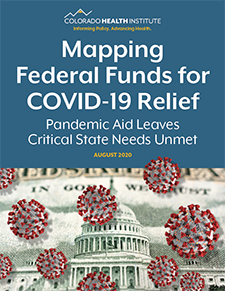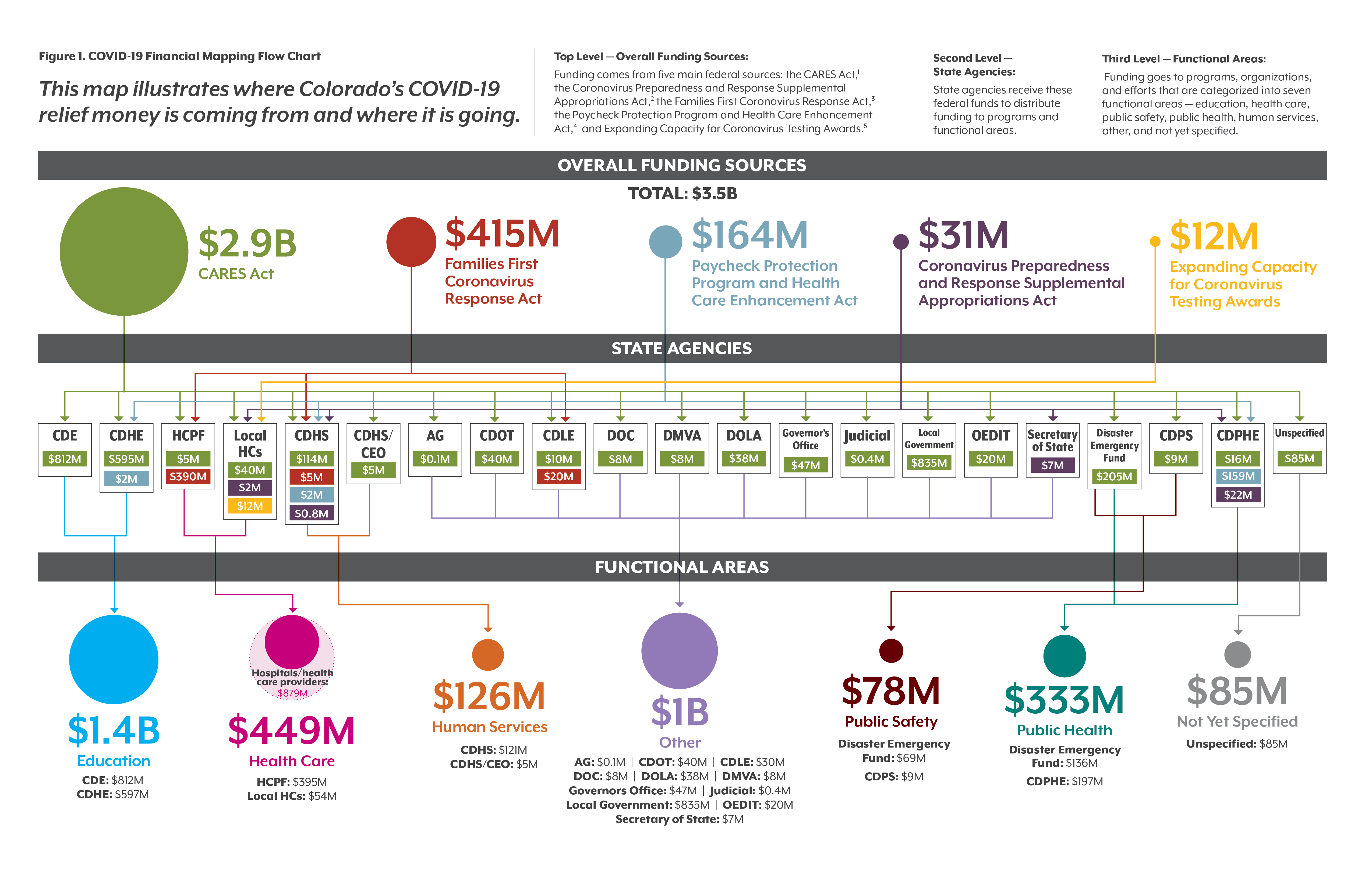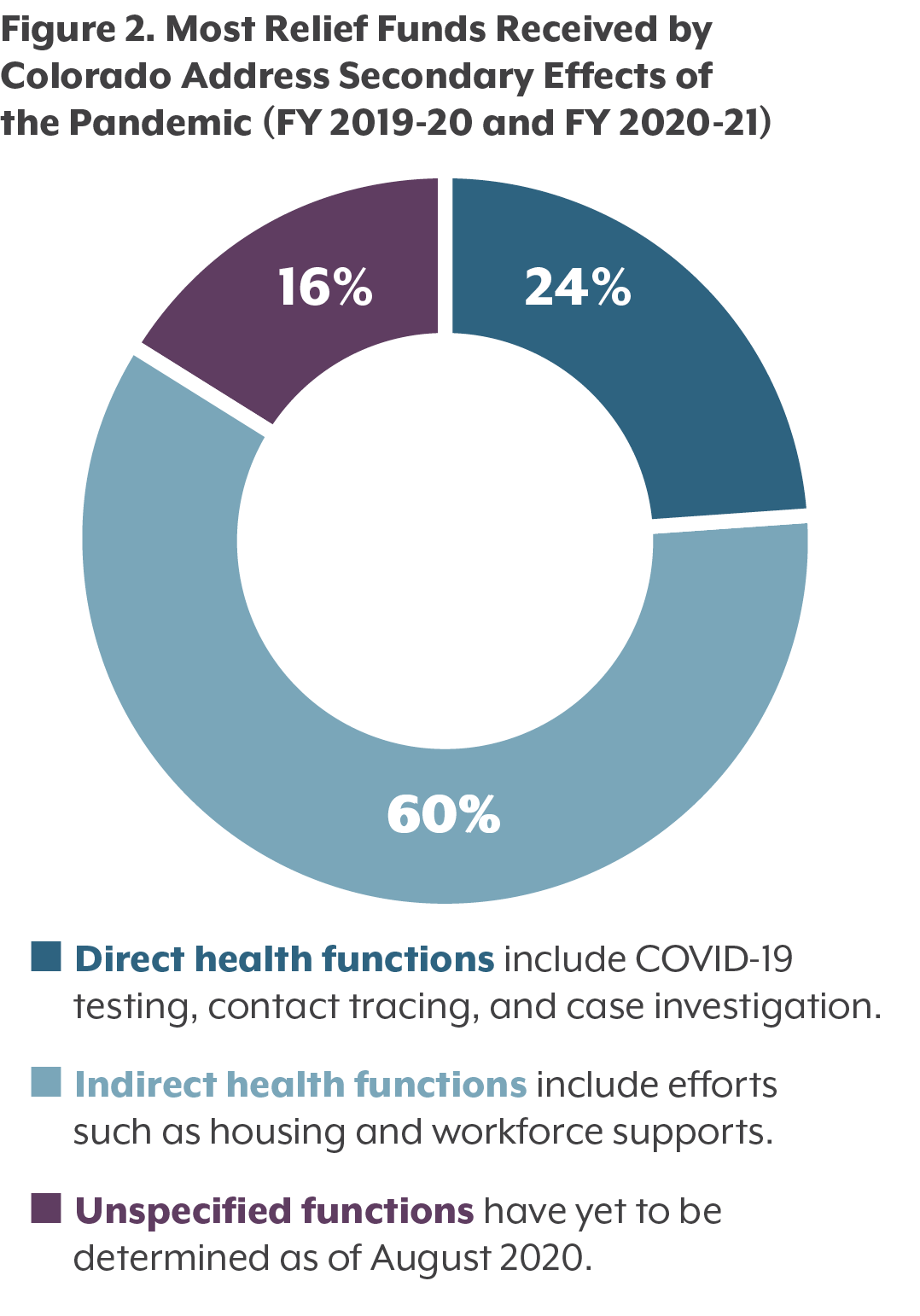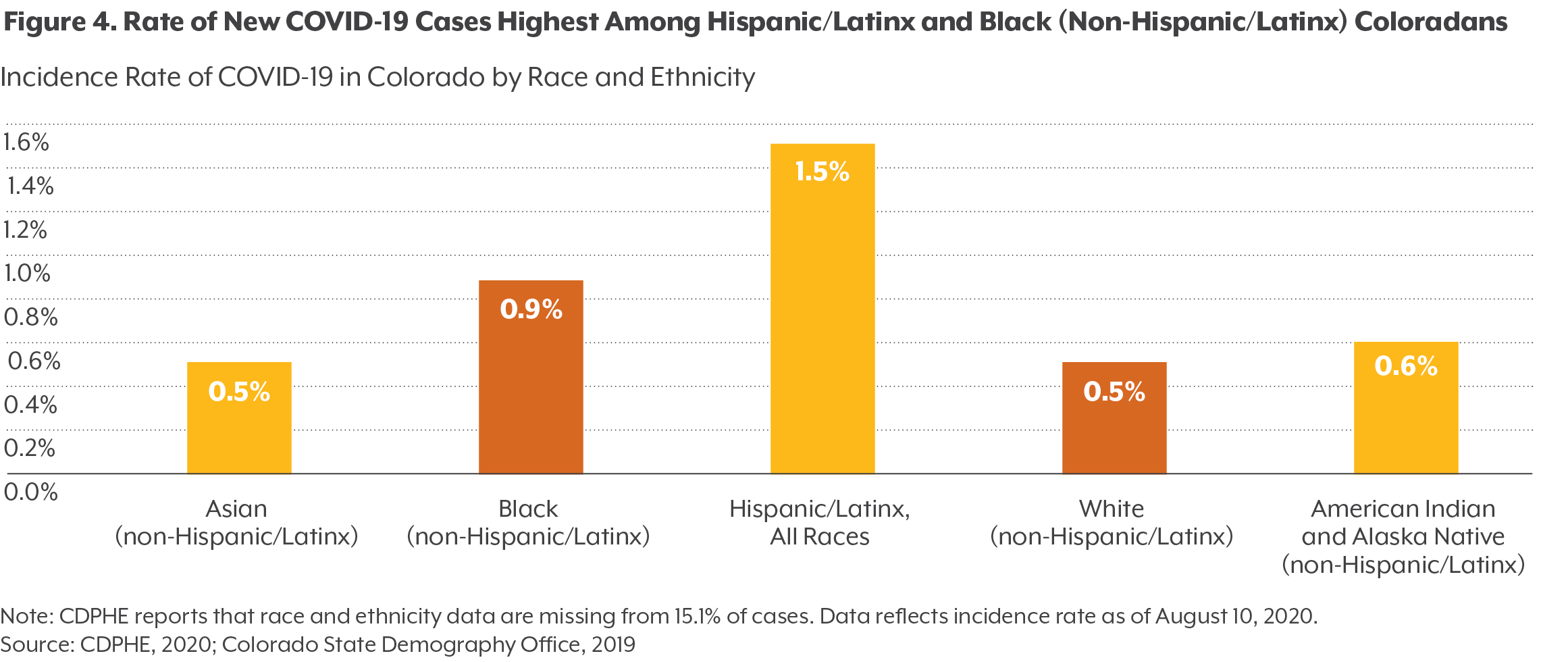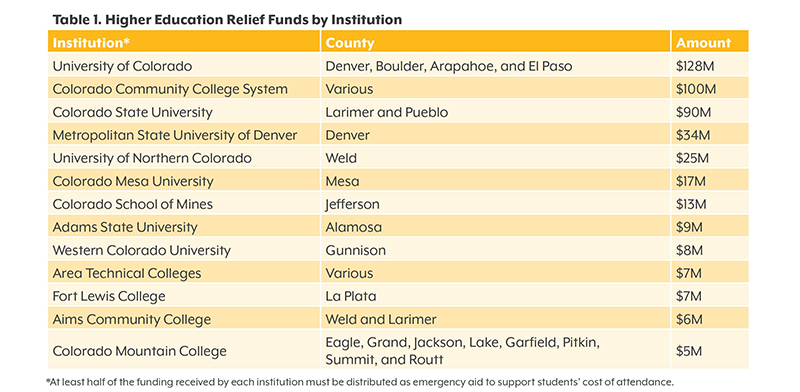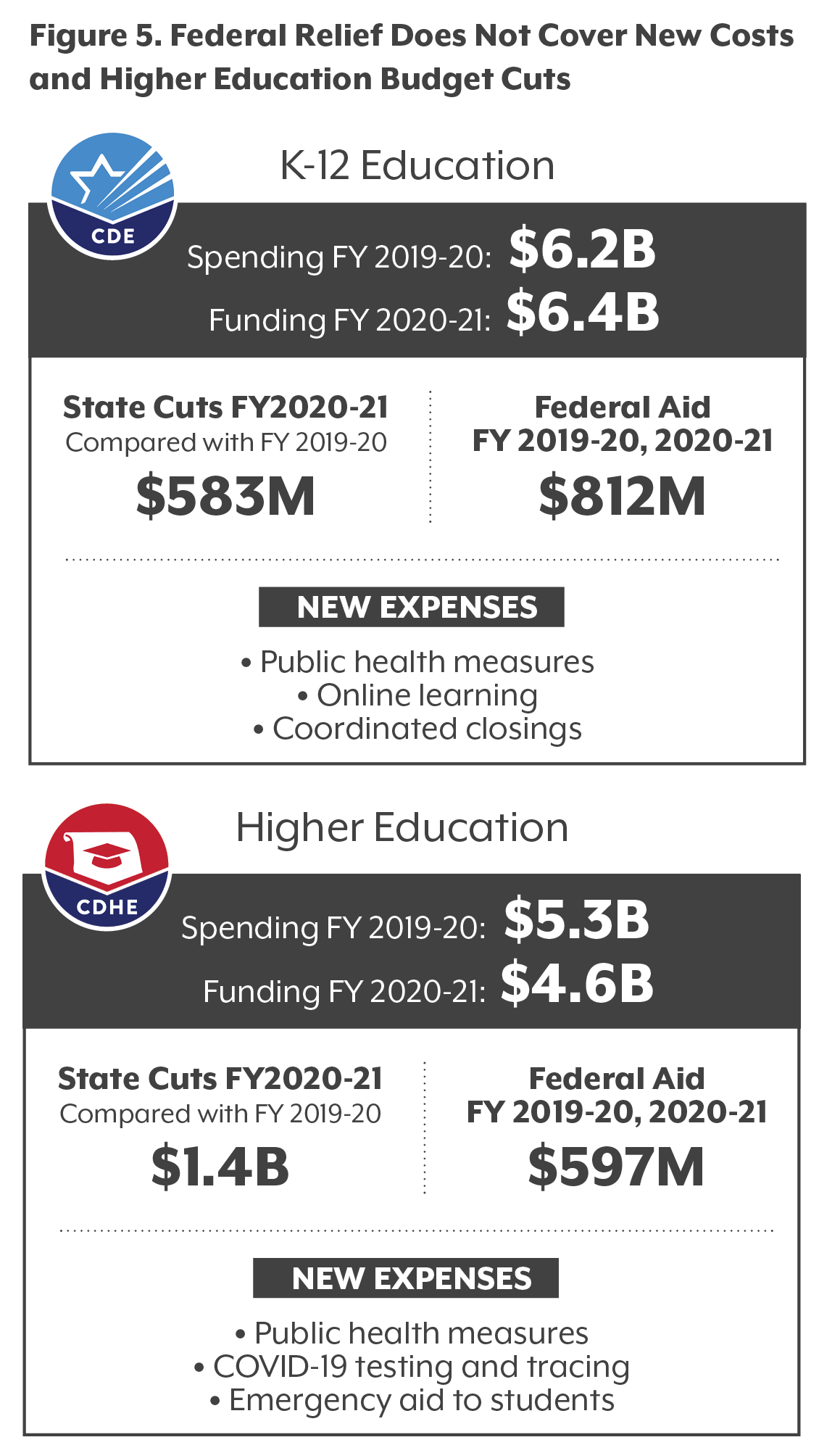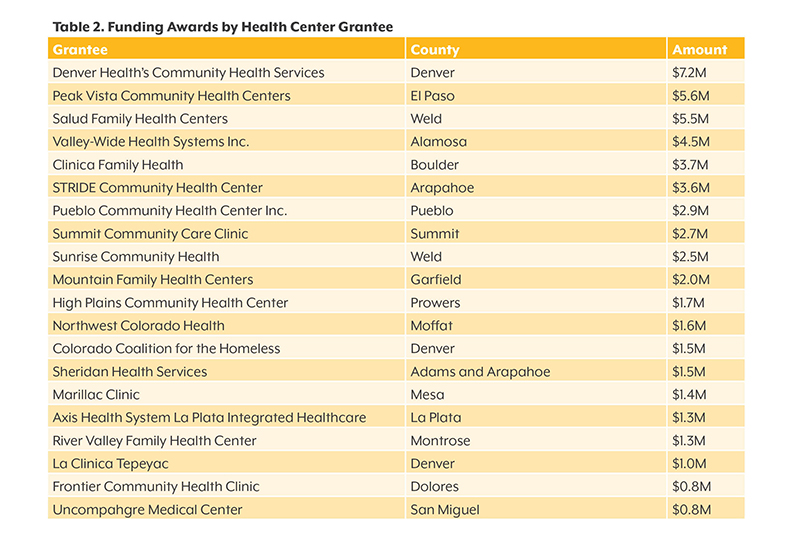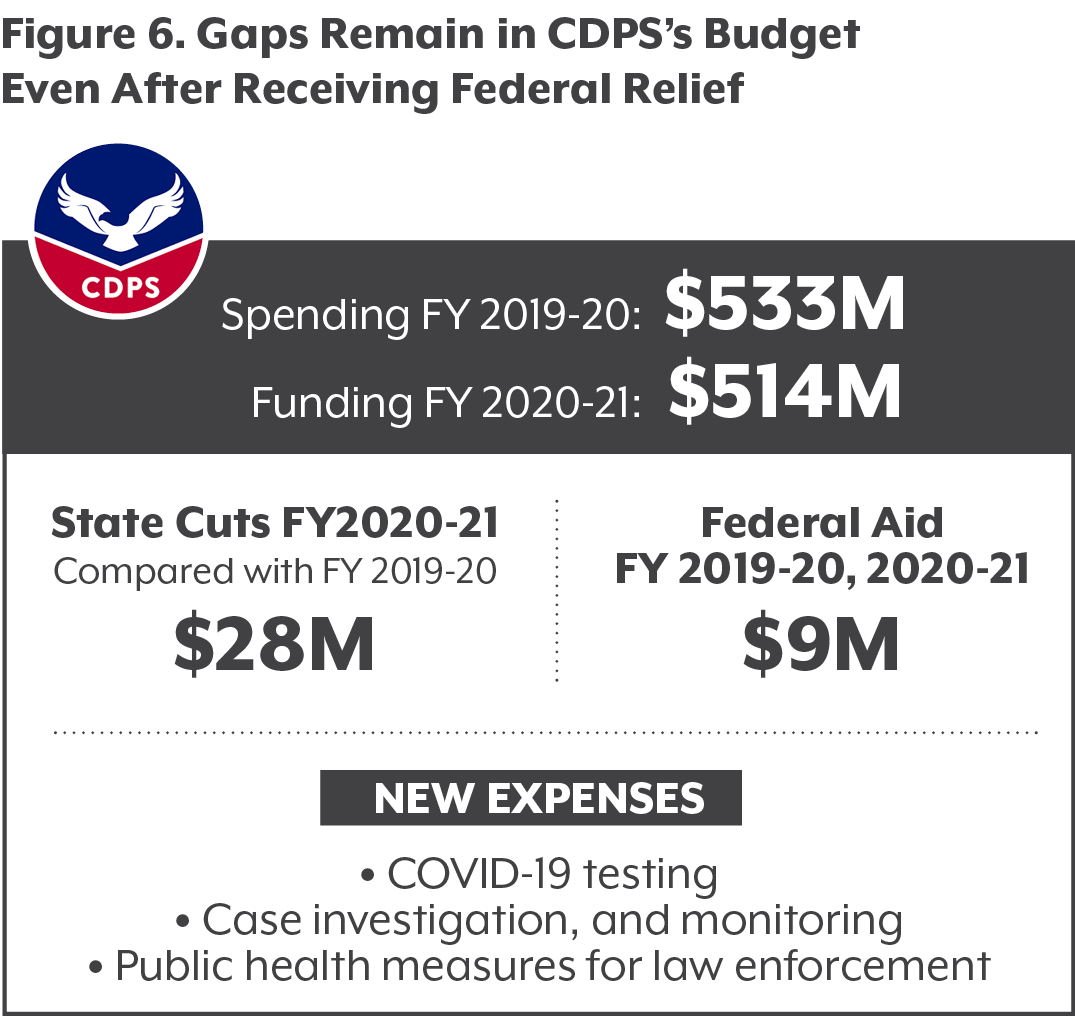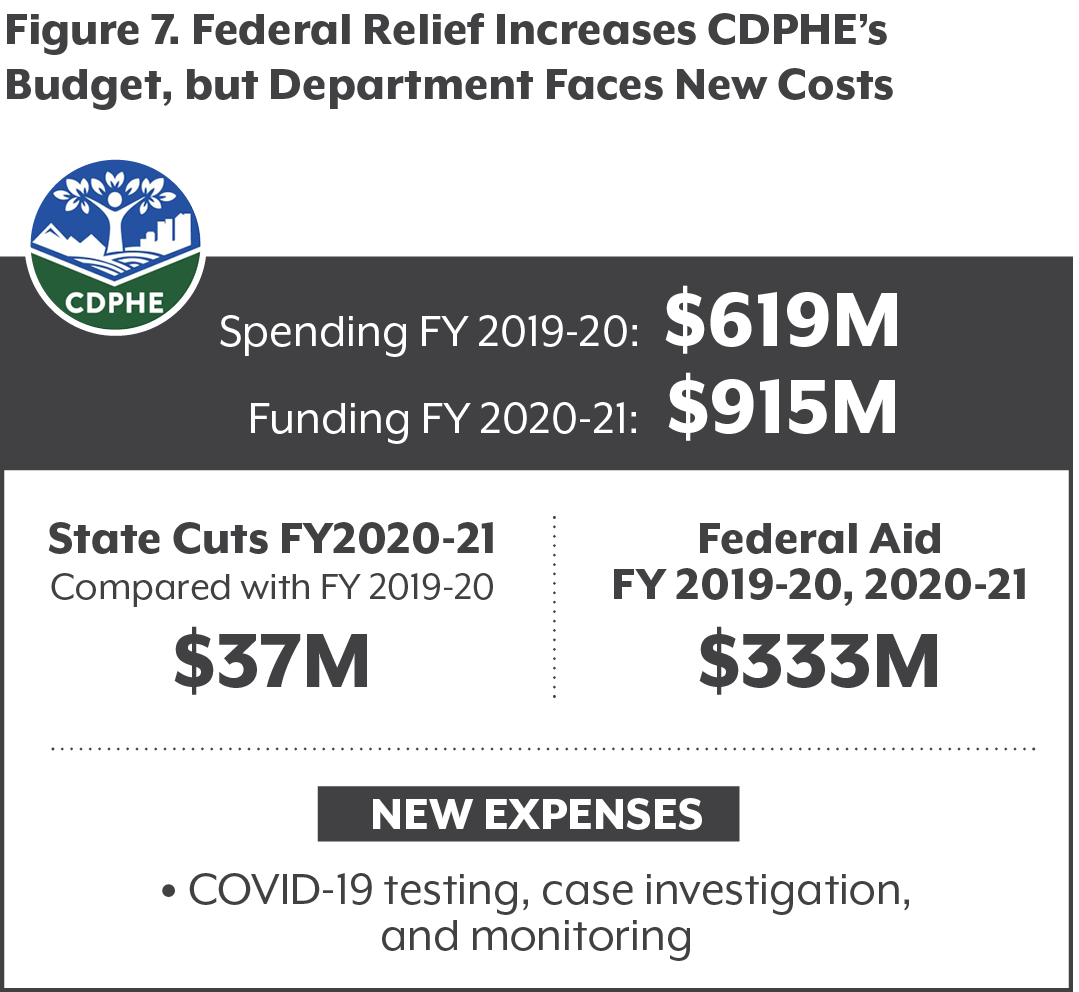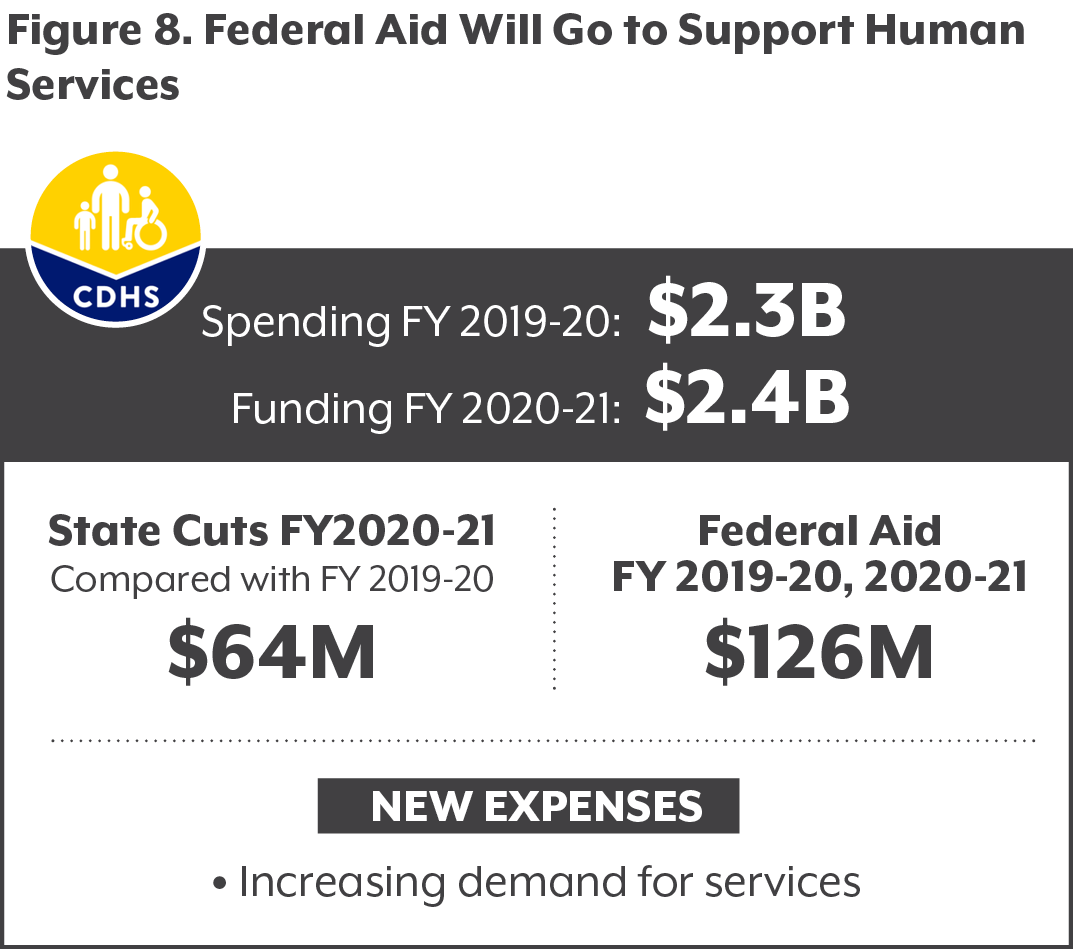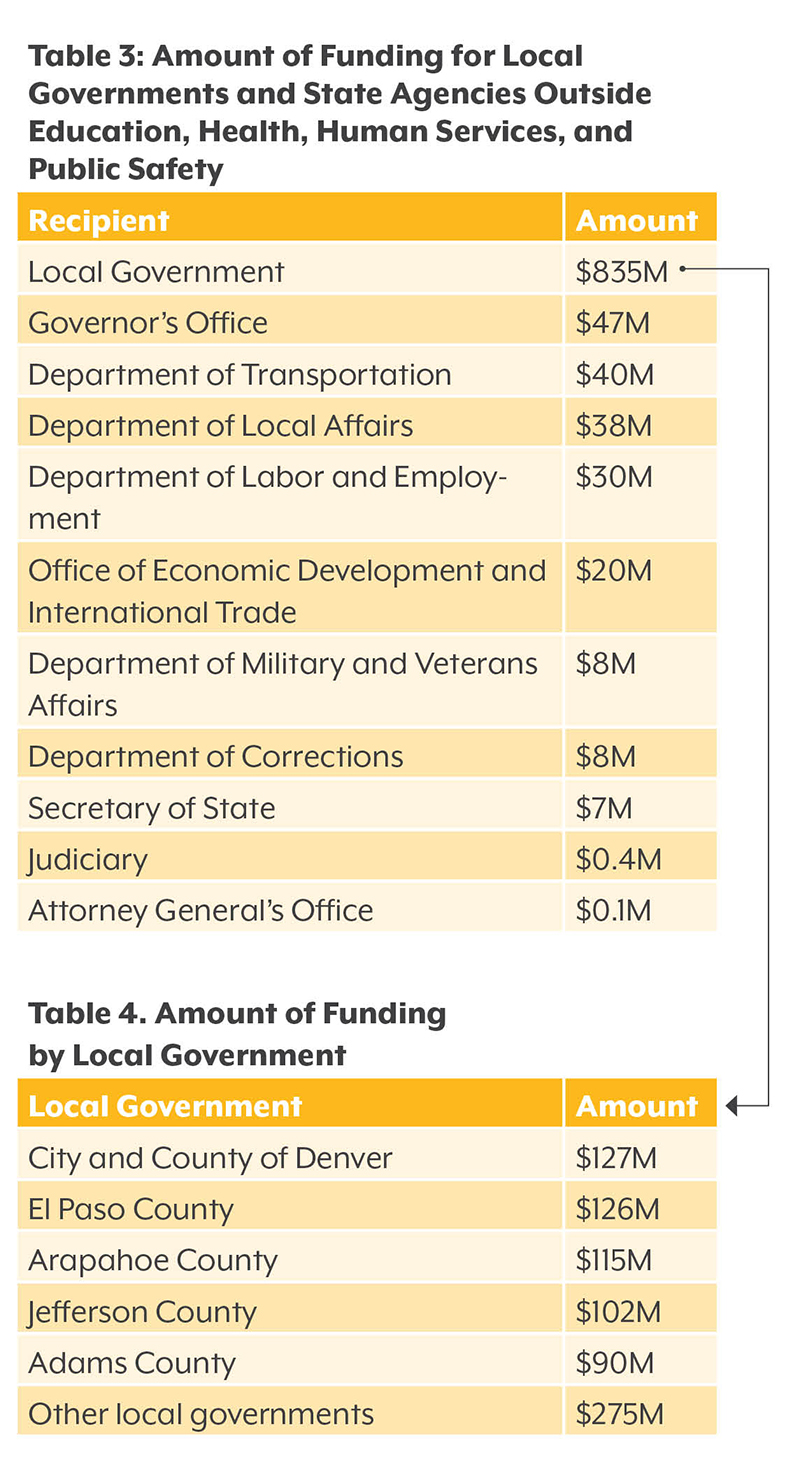This financial map was updated in July 2022. See the latest data at this link.

Mapping Federal Funds for COVID-19 Relief
State and local agencies in Colorado are receiving nearly $3.5 billion in federal funding spread across fiscal year (FY) 2019-20 and FY 2020-21 to support state and local responses to the COVID-19 crisis. Most of these funds ($2.9 billion) are allocated by the Coronavirus Aid, Relief, and Economic Security Act, or CARES Act. Funding for government agencies is just a fraction of the nearly $20 billion coming into the state through direct payments to households, enhanced unemployment benefits, and the Paycheck Protection Program. Those payments are not in the scope of this report.
Of the $3.5 billion, more than 40% ($1.4 billion) is supporting education. Another 13% is going to health care, supporting Colorado’s Medicaid program and local health centers. Public health draws in 9% of the total funds.
Most these funds are going to state agencies, and it remains to be seen which local governments will receive funding. In some instances, however, the communities or institutions that will receive support have already been identified.
This report from the Colorado Health Institute (CHI) analyzes how these funds are being used and where gaps remain. It includes a financial map that can be used as a tool to clarify where, as of August 2020, money is available for critical priorities in Colorado.
While federal funds are allowing Colorado’s state and local government agencies to provide many critical services to address the COVID-19 pandemic, there are new and emerging needs in areas such as education and human services that are not covered by current relief packages.
Understanding the Financial Map
Many state departments were subject to cuts in the FY 2020-21 budget, which covers spending from July 2020 through June 2021. The federal relief addresses some of these cuts, but gaps between proposed and final budget totals remain in some departments, notably the Colorado Department of Higher Education. Other departments are taking on new responsibilities or seeing increased demand for services that may not be addressed even with the support of federal funds. Note that funding to employers through the Paycheck Protection Program is not included in this financial map.
As the state navigates this combination of cuts and increasing demand for services, it is critical to ensure that public dollars are allocated in a way that addresses Colorado’s most pressing needs.
A quarter (24%) of the federal relief supports the COVID-19 response directly, including contact tracing, testing, and other functions related to virus prevention and treatment. These funds are described in this report as addressing the direct impacts of COVID-19. Agencies with funds for these efforts have not yet determined how much funding will ultimately go to testing, contact tracing, case investigation, or isolation supports; they have the flexibility to respond to emerging needs over time.
The majority (60%) of relief funds address the broader aftermath of COVID-19, including the economic downturn and other impacts of social distancing. They are intended to support small businesses, provide housing assistance, promote remote learning, and support a range of other efforts. These funds are described in this report as addressing the indirect or secondary impacts of COVID-19.
The remaining 16% of funds are kept available for state and local agencies to use for payroll expenses and needs to mitigate or respond to the COVID-19 emergency. Since these funds are kept available but have not yet been allocated as of August 2020, this report describes them as not yet specified or unspecified.
It may be surprising that large portions of this funding go to efforts not directly related to disease prevention and control. However, the secondary impacts of COVID-19 include serious unmet needs in other sectors, including education, housing, and technology — factors that also affect Coloradans’ health. For some Coloradans these funds will help make a COVID-19 test available. For others, federal funds will provide access to food or housing that would otherwise have been at risk because of the pandemic.
Who Is Affected by COVID-19?
Recent data from the state’s public health department show that rates of new COVID-19 cases are higher in some groups than others.
As of August 2020, Coloradans 80 and older are most likely to have been diagnosed with COVID-19 (1.4% of this group has been diagnosed with COVID-19), followed closely by those ages 20-29 (1.3%). (See Figure 3.)
The rate of COVID-19 cases is highest among Hispanic/Latinx Coloradans (1.5%), followed by Black (non-Hispanic/Latinx) Coloradans (0.9%). (See Figure 4.)
There are lower rates of COVID-19 among American Indian and Alaska Native (non-Hispanic/Latinx), Asian and Pacific Islander (non-Hispanic/Latinx), and white (non-Hispanic/Latinx) Coloradans. However, many testing data are missing racial and ethnicity identifiers.
Not all communities have equal access to testing. Cost, lack of health coverage, and lack of transportation are among the factors that can pose barriers. Ensuring equitable access to testing could curb disease transmission by providing an accurate understanding of which Coloradans are most at risk.
The pandemic and its economic aftershocks hit Coloradans in different ways depending on where they live. For instance, according to CHI’s Social Distancing Index, neighborhoods in Denver and agricultural communities in northeastern Colorado have higher proportions of essential workers who were less likely to be able to socially distance.
While the financial map does not explore in detail which populations are receiving federal funds, relief supports intended to reach those who are most affected by COVID-19 should include efforts to address needs in these communities. These needs will evolve over time as the pandemic progresses and different communities experience outbreaks and higher incidence rates.
Funding by Sector
EDUCATION
Share of Funding
More than 40% ($1.4 billion) of the federal funds Colorado is receiving go toward education.
Where Is the Money Going?
More than half (58%) of federal relief funds for education go to K-12 schools. The Colorado Department of Education (CDE) received $812 million, which it distributes to K-12 school districts based on their student populations to coordinate long-term school closures, purchase cleaning and sanitizing supplies, and ensure students have access to online learning.
The remaining 42% — $597 million — heads to the Colorado Department of Higher Education (CDHE), which distributes it to state colleges and universities if they do not raise tuition by more than 3%. Funds can be used to comply with public health measures and to provide grants to students for food, housing, course materials, health care, and child care.
Nearly all of these funds address indirect impacts of COVID-19, including the transition to remote learning as school districts close their physical buildings. This funding is intended to assist remote learning, be used as grants for course materials, and support the workforce.
Like most funding received by the state, the federal relief that goes to education departments is restricted, meaning CDE and CDHE are required to follow guidelines from the CARES Act on allocation of the $1.4 billion. Both departments are implementing their own testing and contact tracing methods. But schools may have additional needs that fall outside of restrictions of this funding, especially as they reopen physical buildings.
Is the Money Meeting the Needs?
CDE and CDHE experienced the largest budget cuts in FY 2020-21 of all state departments (see Figure 5). The K-12 budget was cut 9.4% from FY 2019-20 and the higher education budget was cut 27.5%. Even with federal aid, CDHE’s budget will drop to $4.6 billion, down from $5.3 billion in FY 2019-20.
For K-12 schools, federal relief funds are likely insufficient to pay for the new needs involved in providing a safe and high-quality education during the pandemic, even though CDE’s budget is slightly larger than in FY 2019-20. As schools begin to reopen partially or fully in person, they will need to pay for materials and approaches that reduce the spread of COVID-19, such as tests, physical barriers, and creating cohorts of students and teachers.
The two largest school districts in the state — Denver Public Schools and Jeffco Public Schools — announced in July that they would start the upcoming academic year fully remote. But remote learning also has costs, as well as important implications for educational equity, including disparities in access to technology and broadband internet and the potential that closing schools could increase food insecurity in some populations. Students – particularly those who are at higher risk of falling behind – will need technological resources, support from instructors, and access to other services during remote learning.
HEALTH CARE
Share of Funding
Almost 13% ($449 million) of federal COVID-19 funding supports Colorado’s health care system, via both an increase in the federal Medicaid match rate and direct support to local health care centers.
As a result of the enhanced federal match, the state’s Department of Health Care Policy & Financing (HCPF) is receiving most of these federal funds ($395 million). The money cannot be used for HCPF’s administrative expenses.
Health centers are directly awarded $54 million, with the majority coming from the CARES Act and the Provider Relief Fund, which is comprised of funds from the CARES Act and the Paycheck Protection Program and Health Care Enhancement Act.
Where Is the Money Going?
Federal funding received by HCPF supports both the agency’s COVID-19 response and an anticipated increase in Medicaid membership. These funds can be used for testing or treatment of COVID-19, but most will help fund services for increased enrollment in Medicaid due to rising unemployment rates. Whether these funds will result in increases to provider reimbursement remains to be seen, but in the face of tight budgets statewide, this is unlikely.
According to HCPF, nearly 1.3 million Coloradans were enrolled in Health First Colorado, the state’s Medicaid program, in March 2020. The department has projected enrollment to increase substantially due to the economic crisis and job losses caused by the pandemic.
Federal funding also includes $5 million to assist the expansion of Medicaid reimbursement for telehealth services, which can allow access to care across the state when many people are staying at home.
Federal funding received by health centers includes funds to support the workforce and to offer COVID-19 testing and other services.
Is the Money Meeting the Needs?
HCPF is projecting an increase of more than half a million (563,000) enrollees in Medicaid by the end of 2020, though enrollment has been slower than expected in the months since that projection was first released.
Health coverage like Medicaid allows people to access care, which is vital during a pandemic. According to the 2019 Colorado Health Access Survey (CHAS), some groups are more likely to be enrolled in Medicaid than others, including those under age 18 (23.0% of all Coloradans in this group are enrolled), Black (non-Hispanic/Latinx) Coloradans (35.5%) and Hispanic/Latinx Coloradans (30.9%). Additional federal funding that supports the expansion of telehealth has the potential to expand access to care for these Coloradans.
Money that supports Medicaid does not reach all Coloradans, however. People who do not qualify for Medicaid include immigrants without documentation and people whose incomes are just above the eligibility limit but who still struggle to afford health insurance.
Local health centers serve these populations and others who may not be enrolled in Medicaid or health insurance. The Colorado Coalition for the Homeless, for instance, has used federal funds to test people experiencing homelessness for COVID-19, trace their contacts, and reduce transmission.
While health centers have been directly awarded federal funding to support these efforts, it is unlikely that these funds will entirely make up for lost revenue due to forgone care during the pandemic, mandatory closures of non-essential clinics such as school-based clinics and dental clinics, and state budget cuts.
Hospital and Other Provider Supports
Hospitals, health centers, and other providers across the state got an additional $879 million from the Provider Relief Fund and are expected to receive more in the coming months. This funding is excluded from this analysis because these funds are sent straight to these providers without flowing through the state government and the final amount of funding is not yet known as of August 2020.
However, this support is referenced in the financial map diagram on pages 4 and 5 as important context. Health care in Colorado is delivered through a public-private partnership, and providers play a key role in the delivery system.
PUBLIC SAFETY
Share of Funding
Around 2% of federal funds go toward public safety to ensure the state can respond directly to the impacts of COVID-19. More than $78 million is allocated by the state’s Disaster Emergency Fund and the Colorado Department of Public Safety (CDPS).
Where Is the Money Going?
All federal relief for public safety responds directly to the COVID-19 emergency.
The Disaster Emergency Fund provides immediate assistance to state, local, and tribal governments. This includes helping communities with COVID-19 testing, implementing case investigation processes, and monitoring how the virus is spreading through the community.
CDPS is using some funds to create grants to local law enforcement and criminal justice agencies for direct health functions such as personal protective equipment and sanitizing devices.
Is the Money Meeting the Needs?
CDPS’s focus includes criminal justice, the State Patrol, and emergency management. State and local governments are given discretion in how to use funds devoted to public safety.
Federal funding does help with some of the budget cuts CDPS experienced in FY 2019-20, but not all.
While some gaps remain at CDPS, the Disaster Emergency Fund equips communities for current and planned public health expenses. As the pandemic continues, demands of public safety services will continue to increase, including creating initiatives that connect communities to resources and additional cleaning in prisons and jails to mitigate potential outbreaks.
The course of the pandemic in the coming months will determine how officials decide to direct these funds.
PUBLIC HEALTH
Share of Funding
CDPHE receives $333 million in federal COVID-19 relief funds, which is 9% of the state’s total.
Where Is the Money Going?
This funding is intended to slow the spread of COVID-19 and the impact of the disease in all communities and geographies of the state.
Of the federal relief funds received by the state’s public health agency, $192 million (57%) supports the direct impacts of the disease through efforts such as the Hospital Preparedness Program, which helps health care systems prepare and respond to COVID-19.
CDPHE has not identified how the $192 million in funding intended to address the direct impacts of COVID-19 will be used as of August 2020, though $60 million will be passed through to local public health agencies and tribes. Budgets for testing have not been differentiated from budgets for contact tracing. The agency has the flexibility to determine how it will allocate these funds and has so far released very little public information about its plans.
Another $136 million (41%) of CDPHE funding was allocated through the Disaster Emergency Fund.
The remaining $5 million (2%) supports other state initiatives such as creating mental health first-aid trainings and assisting local public health agencies with immunization efforts for flu and measles, mumps, and rubella, which will be important as flu season approaches and potentially strains hospitals’ intensive care units.
Is the Money Meeting the Needs?
Federal funding resulted in CDPHE’s budget growing, but demand for the agency’s programs and services — especially those involving direct pandemic response — are also dramatically increasing. Other programs have been cut altogether.
While the department got funding to support testing efforts across the state, Colorado ranks low among states in testing per capita. Test results have also taken 10 or more days to come back, which can limit their usefulness. The long wait times speak to high demand for services and perhaps a workforce that is stretched too thin.
Public health experts are concerned about populations that are not receiving adequate testing, including people experiencing homelessness, people of color, and people lacking transportation, which is necessary for most free drive-through testing.
What Do Direct Funds Include?
• Enhancing case investigation, contact tracing, and outbreak response, especially in high-risk settings and among at-risk populations
• Improving COVID-19 monitoring and reporting
• Strengthening laboratory testing
• Enhancing workforce capacity, such as hiring contact tracers
HUMAN SERVICES
Share of Funding
Human services is receiving 4% of federal relief funds. The Colorado Department of Human Services (CDHS) is receiving almost $126 million to help fund programs and organizations around the state.
Where Is the Money Going?
A small portion (3%) of these funds supports direct COVID-19 efforts, with the rest supporting secondary impacts of the pandemic.
Populations supported by CDHS include older adults, people experiencing family violence, people needing mental and substance use supports, those needing housing assistance, and people in rural communities.
Much of the funding from CDHS will pay for new and existing mental health and substance use services, which aim to address the emotional and mental burdens that this pandemic and recession have put on many Coloradans.
For example, CDHS used federal funds for a grant to help develop the state’s 2-1-1 call line, a confidential service that connects residents to vital resources. Some federal funds support substance use disorder screening, intervention services, and referrals to treatment.
Is the Money Meeting the Needs?
The legislature cut CDHS’s budget by 2.7% this past year. While federal aid more than makes up for this loss, the state can expect demand for many of CDHS’s programs to increase.
Most of the agency’s funds will be used to address secondary impacts of COVID-19, which include aging and disability supports, family violence prevention support services, and substance use disorder treatment services. It is not clear how much federal relief funding will be dedicated to each of these programs.
It is clear, however, that the pandemic is impacting mental health. There has been an increase in both the frequency and length of calls into the Colorado Crisis Services hotline, and over one-third (34.2%) of Colorado adults reported symptoms of anxiety or depressive disorder in June 2020, compared to 21.5% of Coloradans who reported any mental illness prior to the pandemic. Drug overdose deaths also have increased over the course of the pandemic. CDPHE recorded 443 overdose deaths in Colorado from January to April 2020, a 35% increase from the same time period in 2019.
Even prior to COVID-19, data from the CHAS show that 13.5% of Colorado adults did not get needed mental health services and 2.3% did not get needed substance use disorder services in 2019. While a portion of the federal relief will hopefully improve access to behavioral health, the need for mental health and substance use services continues to grow, and human services programs will have to be able to reach people both in person and remotely.
OTHER SERVICES
Many other state departments, programs, and agencies are receiving funding to support both direct and indirect expenses of the pandemic.
Share of Funding
These agencies receive nearly $1 billion in federal funds. Of this total, 28% goes toward direct public health efforts, 18% goes toward the aftermath of the disease, and 54% remains unspecified but will go to support staffing needs across multiple agencies.
Where Is the Money Going?
Local governments are given the majority of these funds to aid in directly reducing transmission, increasing testing, and tracing contacts of infected people (see Table 3). Some federal funds from the CARES Act are directly allocated to local governments with populations exceeding 500,000 – Adams County, Arapahoe County, City and County of Denver, El Paso County, and Jefferson County – while a smaller portion is dedicated to local governments that did not get a direct allocation, including those in rural parts of the state (see Table 4).
Local governments can use this funding in different ways. The Denver Department of Public Health and Environment, for instance, used some for a grant to fight hunger during the pandemic.
Some state departments have already specified how their funding will be used. The Department of Local Affairs will use a portion of its funds on the Property Owner Preservation Program, which provides rental assistance, mortgage assistance, and guidance on how to access other housing services.
Is the Money Meeting the Needs?
An analysis from CHI combined all state agencies in this functional area to assess whether gaps remain. At a high level, CHI found the federal relief is equal to state budget cuts.
However, every state agency will have new expenses related to COVID-19 and its impacts. And even with these federal funds, not all state agencies come out in the black, and some programs have been cut and are not restored by federal funding.
The Department of Law, also known as the Attorney General’s Office, took a $1 million budget cut in FY 2020-21 and only got around $100,000 for the Safe2Tell program, an anonymous service used by young people to report threatening behaviors. While tips have decreased due to remote learning, this office is working to coordinate efforts between Safe2Tell and the statewide crisis line to ensure important issues like suicide do not get lost in the chaos of the pandemic.
Conclusion
The majority of federal funds are set aside to cope with the aftermath of COVID-19 and help address significant cuts made to the state agencies’ budgets in FY 2020-21. But gaps remain in key state functions. Colleges and universities are taking large budget cuts even with federal relief funding. Other state departments are breaking even but are seeing large increases in demand for their services. In local governments, there is uncertainty surrounding how funds will be used and who funds will help.
Almost a quarter of federal relief has been and will continue to be spent on COVID-19 itself: tracking who has it and where it is traveling, and treating patients within the health care system.
Plans for some funds — such as federal funds which support local governments — have not yet been specified. This lack of specificity reflects the need for flexibility and adaptability in the coming months as the pandemic continues to challenge communities across the state.
Coloradans will need clarity on how federal funds are being spent and whether they are meeting the real needs of the state’s residents. This analysis is a step toward understanding how these funds are being used.


